Isla Espíritu Santo
Isla Espíritu Santo is an island in the Gulf of California, off the Mexican state of Baja California Sur. It is separated from Isla Partida by a narrow canal.[1]
| --> | |
|---|---|
.jpg.webp) Aerial view of Isla Espíritu Santo (right) and Isla Partida (left) | |
 Isla Espíritu santo-- or | |
| Geography | |
| Location | Gulf of California |
| Coordinates | 24°28′17″N 110°19′57″W |
| Adjacent bodies of water | Pacific Ocean |
| Area | 80.763 km2 (31.183 sq mi) |
| Administration | |
Mexico | |
| State | Baja California Sur |
| Municipality | La Paz |
| Demographics | |
| Population | Uninhabited |
It has a land area of 80.763 square kilometres (31.183 sq mi), the 12th-largest island in Mexico. Isla Partida's land area is 15.495 square kilometres (5.983 sq mi). They are part of La Paz Municipality and are both a short boat trip from La Paz on the Baja California Peninsula.
There was human presence of the island already about 9,000 years ago.
Biosphere

The area is protected as part of the Área de Protección de Flora y Fauna - Islas del Golfo de California (APFF-IGC),[2] and is an important eco-tourism destination. It was declared part of a Biosphere Reserve by UNESCO in 1995.[3] Espíritu Santo is the only known habitat of the black jackrabbit.[4] The islands are both uninhabited. Ensenada Grande beach, on Isla Partida, was voted the most beautiful beach in Mexico by The Travel Magazine [5] and one of the top 12 beaches in the world. Sea kayaking is a popular activity around the island.
The surrounding reefs are home to parrotfish, angelfish,[6] trumpetfish, Moorish idols, and rainbow wrasse, while many other species pass nearby including sharks, rays, turtles, dolphins, and even whales. Birds include brown pelicans, great blue herons, snowy egrets, turkey vultures, and hummingbirds. A large sea lion colony resides on Los Islotes, off the north tip of the islands; snorkeling with the females and young is a highlight of many tours.[7]
Geology
Located in the Sea of Cortez (45 minutes by boat from the busy hub of La Paz), you will find the enchanting islands of Espíritu Santo and Isla Partida: A fascinating 80.763 km/31.183 square-mile rock formation whose origins can be explained by a series of cataclysmic earthquakes shaking its minerals to the surface. A geologic rainbow of pink, brown and beige rows reveal the secrets of its birth as volcanic ash and lava residing in its ancient walls. A shallow channel separates Espíritu and Isla Partida and this is sometimes, in the right tide, shallow enough to wade across. Espíritu Santo is the twelfth largest island in Mexico. Nobody inhabits the island. The area is protected as part of the Area de Protection de Flora y Fauna – Islas del Golfo de California and is an important eco tourism destination. UNESCO declared the island a protected biosphere reserve and Ensenada Grande beach, on Isla partida, was voted the most beautiful beach in Mexico by The Travel Magazine. With its white sand, turquoise waters and rustic back-drop you can really see why.
Disastrous Destiny
Conservation-minded eco-adventurers were not the only ones attracted to the island, and by the 1990s the pressure on Isla Espiritu Santo was intense: a real estate developer wanted to create a resort casino on the island. Luckily Tim Means (environmentalist),[8] founder of Baja Expeditions, who since 1974 had been a leading conservationist based in La Paz, formed a coalition of activists who were able to purchase part of the island from the ejido that was selling it to the casino resort developer. One-third of the funds came from Mexican funders, another third from American funders via the Nature Conservancy, and the rest through an anonymous gift to the World Wildlife Fund. Their subsequent donation of Isla Espiritu Santo to the nation is commemorated by a famous sculpture of a dove on the boardwalk in La Paz.
Archaeology
.jpg.webp)
Early Holocene pearl oyster circular fishhooks, dating to 8750–8500 cal BP, have been discovered on Espíritu Santo Island. They've been found in Covacha Babisuri rock shelter on the island. This is one of the earliest known examples of shell fishhooks in the world.[9]
"The pearl oyster fishhooks and some of the associated tools from Espíritu Santo Island, in the southern Gulf of California in Mexico, are similar to those found in Australia, along the Arabian Sea (Roth 1904, Allen 1996, Beech 2003, Méry et al. 2008), and in Valdivia (Meggers et al. 1965:147)."[9]
Similar fishhooks have also been reported from Cedros Island, also in Baja California.
See also
References
- Áreas de Protección de Flora y Fauna - Islas del Golfo de California Archived 2015-03-28 at the Wayback Machine, Government of Mexico (in Spanish)
- UNESCO, Islas del Golfo de California Biosphere Reserve, UNESCO Biosphere Programme.
- Romero Malpica, F.J. & Rangel Cordero, H. (2008). "Lepus insularis". IUCN Red List of Threatened Species. 2008: e.T11794A3308250. doi:10.2305/IUCN.UK.2008.RLTS.T11794A3308250.en.
- "Isla Espiritu Santo". Archived from the original on 27 September 2007. Retrieved 19 March 2011.
- Goodson, Gar; Weisgerber, Phillip J. (1988). "Angelfishes". Fishes of the Pacific Coast. Stanford University Press. p. 92. ISBN 9780804713856. Retrieved 19 August 2016 – via Google Books.
- "Baja Insider".
- "Saving Espiritu Santo".
- Fujita, Harumi (2014). "Early Holocene Pearl Oyster Circular Fishhooks and Ornaments on Espíritu Santo Island, Baja California Sur". Monographs of the Western North American Naturalist. 7 (1): 129–134. doi:10.3398/042.007.0113. ISSN 1545-0228.